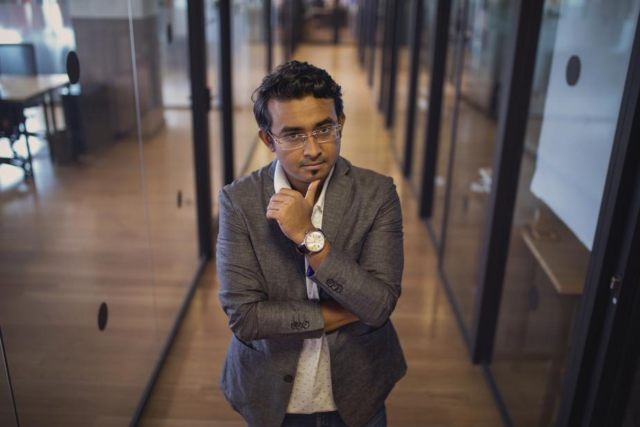This article is the first in a six-part series on mindful leadership from expert and consultant Puja Madan. To understand what “mindful leadership” is and why it’s critical for your organization, keep reading.
I was born and raised in India and spent my professional years there living a double life.
In one world, equipped with an MBA, I was a part of India’s booming tech ecosystem and worked in various management positions at tech startups, launching products, managing teams, striking deals with vendors and partners, and keeping insane hours.
In the other world, as an avid seeker of higher consciousness, I used all my free time meditating, traveling to meet awakened masters, and exploring Eastern mindfulness techniques, holistic health, yoga, tai chi, and spiritual philosophy.
In the mornings, I would read TechCrunch, review use cases and write blog posts.
In the evenings, I would learn new meditations and listen to talks about Taoism, Sufism, Vedic scriptures, and Zen Buddhism.

Although I was learning profound truths on my mindfulness journey, it was also apparent that the approach and language of some of these teachings was very esoteric, almost disconnected from the real, practical world of business and leadership. What if someone didn’t have the time or dedication to travel and immerse themselves in ten-day-long silent retreats?
How could the work of mindfulness — that was profoundly shaping my leadership — be made more accessible to others like me who were burning out on their way to the top?
I knew I could — and had to — find a way to merge these two worlds, to find a healthy, balanced union of:
- Milestones and mindfulness
- Planning and playfulness
- Implementation and intuition
- Work and wonderment
- Framework and flow
- Doing and being
After moving to America in 2011, I enrolled at the Institute for Integrative Nutrition, New York to deepen my understanding of holistic health and wellness. Shortly after that, I began offering mindful leadership trainings and executive coaching to stressed-out executives and leaders who were feeling the need to anchor into an inside-out model of leadership.
The results were astounding, even to me. It became obvious that in catering to the demands of their work, other areas of my clients’ lives were suffering: some were on the brink of divorce, some had unhealthy eating habits or hadn’t exercised in months, some were experiencing high levels of anxiety and stress.
 Through intentional practices and simple mindfulness techniques, things began to shift, at work and in the personal realm. Says Suzanne, a small business owner:
Through intentional practices and simple mindfulness techniques, things began to shift, at work and in the personal realm. Says Suzanne, a small business owner:
“Before Puja’s training, my life was hectic, unorganized, and lacking true direction. I felt like I was constantly running from one task to another, while not ever able to focus on any long-term goals.
Now, I am much more organized. And I also respect my time, as well as others much more. I am able to really listen to my body, as well as my heart and ‘gut’ with confidence.
I also have a better at ‘letting things go’ when people don’t react or situations don’t play out as I would want or expect them to. It makes for a much calmer ‘me’ which makes my marriage easier and happier, as well as my everyday tasks! I always thought that compassion toward others was my biggest strength, yet my compassion for myself and others has increased ten-fold! Needless to say, my business has been the biggest beneficiary of this work.”
But let’s first start with the basics — what is mindfulness and how does it work?
What Is Mindfulness?
Mindfulness is derived from the Sanskrit word sati: the practice of actively attending to the present moment. When we are fully present and able to hold space for our thoughts and feelings in a non-judgmental, compassionate way, a few things happen.
First, we begin to access our inner resources and intelligence in a way we can’t when our minds are over-active, stressed, or pre-occupied. In this state:
- We make decisions faster and more intuitively.
- We develop greater resilience to bounce back from challenges and hardships.
- We come up with creative solutions more easily.
- We’re able to break old unhealthy patterns of behavior.
In short, we tap into our innate creative life force energy, which propels us forward into our full potential.
Second, mindfulness cultivates deeper levels of self-acceptance and self-compassion that we’re then able to extend to others. This is a powerful inner shift, especially for leaders, who are in the business of relationships and have traditionally tried to acquire these qualities intellectually and extrinsically.
How Leaders Benefit From Mindfulness
Ultimately, our greatest asset as leaders is our self-awareness, which paves the road for self-mastery.
Imagine the sailing ship that has multiple holes in its sail. It chugs along slowly, painfully, creakingly — but is unable to harness the full power of the wind and waves. Leadership is like that ship. Unless we plug all the holes draining our vital, creative, life force, we can’t move effortlessly and quickly into the direction of our goals. Through mindfulness we’re able to plug all that is draining our energy and time so we can lead with intention, integrity, and true power.
At The Mindfulness Map, we have a two-pronged approach to mindful leadership involving the following areas of awareness:
- Awareness of the Present Moment
- Awareness of Beliefs, Perceptions, and Biases
Awareness of the present moment helps with:
- Stress and anxiety management
- Time management
- Resilience and agility
- Conscious communication
- Innovation and creativity
Awareness of beliefs, perceptions, and biases helps leaders develop the following into their company culture:
- Values and purpose
- Empathy and compassion
- Conflict resolution
- Gender equity
- Diversity and inclusion
 Mindful Leadership Doesn’t Stop There
Mindful Leadership Doesn’t Stop There
Here are all the areas where mindful leadership benefits leaders and their companies:
-
Resilience and Agility
Mindfulness can teach the mind to manage emotions more effectively and productively. It allows leaders to reset, recharge, and gain a positive perspective quickly.
-
Vision and Leadership
Mindfulness training increases leadership skills like inspiring a shared vision and demonstrating moral intelligence. It also enables executives to consciously choose what’s best for the individual, team and organization.
-
Conflict Resolution
Mindfulness creates stronger, healthier team-dynamics, a more positive work culture and conscious communication strategies to prevent or address conflict.
-
Focus and Clarity
Mindfulness can improve working memory, executive function, and focus. Executives stay on the same tasks longer, make fewer switches and report more work fulfillment.
-
Creativity and Innovation
The state of relaxation achieved through mindfulness facilitates enhanced creativity, innovative solutions and the ability to look at problems in a fresh light.
-
Empathy and Compassion
Mindfulness reduces perceived threats, resulting in leaders who lead with a calmer, collaborative, compassionate, open-minded and non-judgmental temperament.
-
Diversity and Inclusion
Mindfulness helps executives decrease unconscious biases, see others as equals, and rely less on previously established associations to hire, train and lead teams.
And here are some statistics on how mindfulness helps organizations:
- 66% better manage their stress
- 60% increased focus and better decision-making
- 34% performance under pressure
- 46% increase in innovation and creativity.
- 91% positive impact on company culture
The Embodiment of Mindful Leadership
I want to stress that through mindfulness these qualities above aren’t just intellectually processed and externally acquired, instead they are internalized and become part of us just as our sense of humor or our height is a part of us — we can’t extract it out.
Through mindfulness, leaders begin to show up in deep alignment between who they are, what they believe, and how they act. Mindfulness becomes the mirror to reflect their true self back to them, so they can pause, reflect, and course-correct when needed.
Mindful leaders embody a kind of conscious leadership that inspires others not through their talk, but through their walk — through mindful actions, choices, and their very presence. They become catalysts. They spark a ripple effect that trickles down into the organization.
To paraphrase Gandhi’s words, mindful leaders become the change they wish to see in others, they create a culture of mindfulness in their organizations by being mindful themselves.
And I want to help you create this change, as well.
Let’s Explore Mindful Leadership Together
Over the coming weeks, we’ll explore how to bring mindfulness into very specific disciplines of leadership. The topics we’ll be covering are:
- Creating Calm: Managing Power Stress and Cultivating Resilience
- Creating Space: Exploring Different Meditation Styles to Find ’The One’
- Creating Time: Infusing Productivity with Purpose and Presence
- Creating Trust: Creating Win-win Outcomes Through Conscious Communication Frameworks
- Creating Inclusiveness: Exploring Implicit Bias and Rewiring the Brain
Each of these articles will provide you with simple and practical ways to infuse mindfulness into different areas of leadership so your full potential as a purpose-driven leader can be sparked and sustained.
I look forward to your reading your thoughts and comments.




